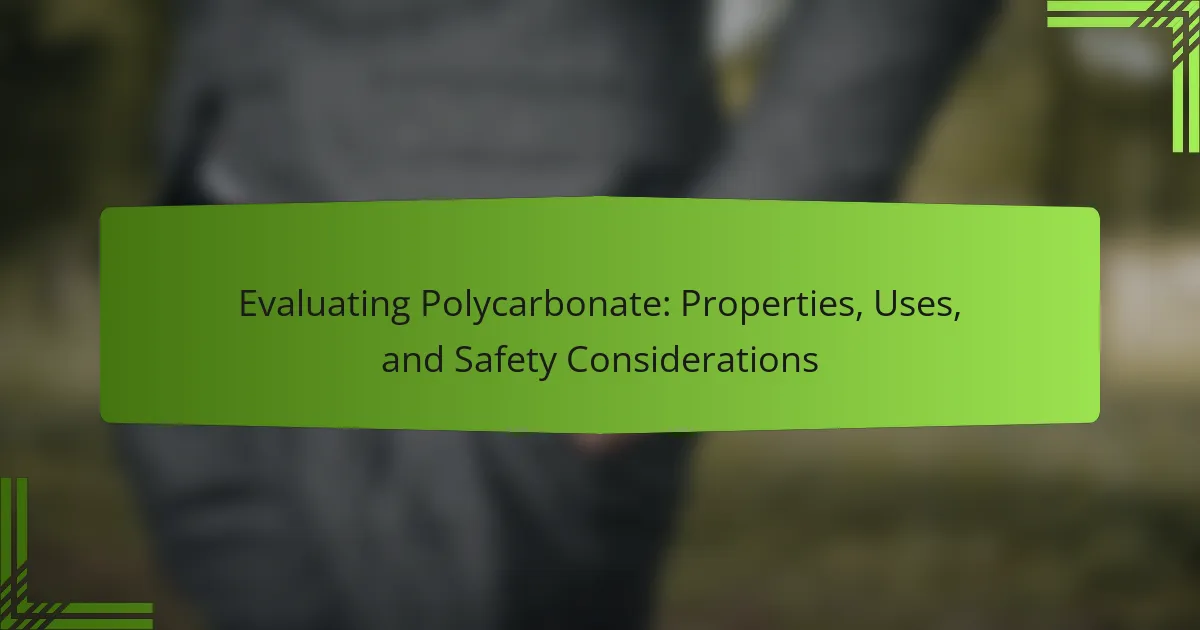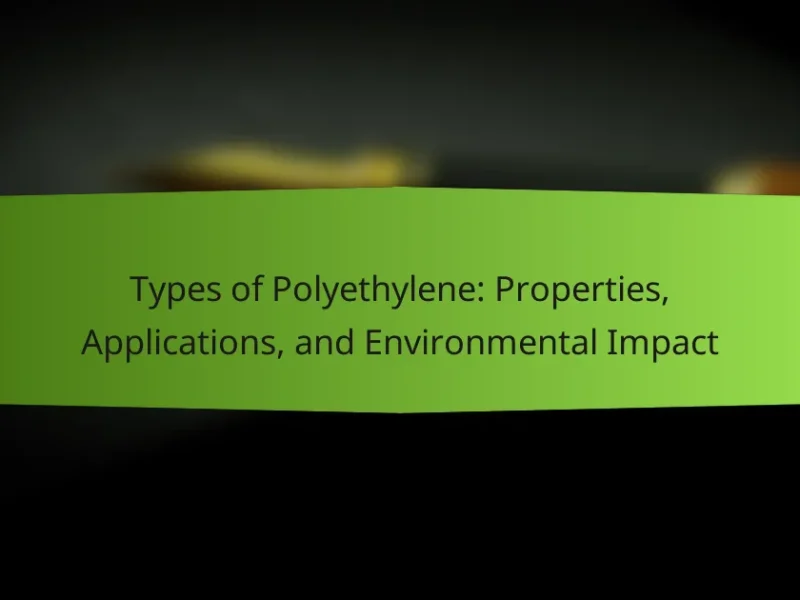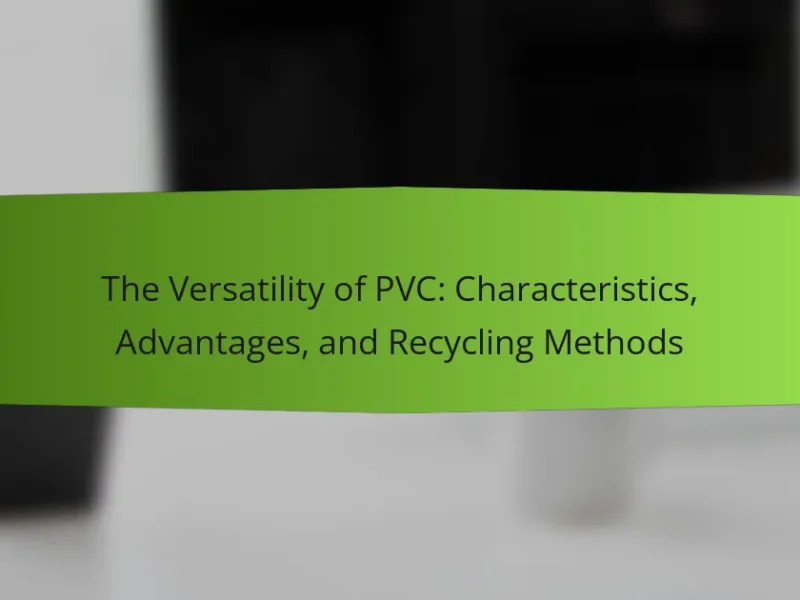Polycarbonate is a durable thermoplastic polymer recognized for its strength, transparency, and high impact resistance. It is commonly utilized in various applications, including eyewear lenses, safety goggles, electronic components, and construction materials. This polymer can withstand extreme temperatures and offers UV resistance, making it suitable for protective gear and automotive parts. However, safety considerations regarding UV degradation and potential chemical release at high temperatures are essential for its application. This article evaluates the properties, uses, and safety considerations of polycarbonate, providing a comprehensive overview of its versatility and importance across multiple industries.
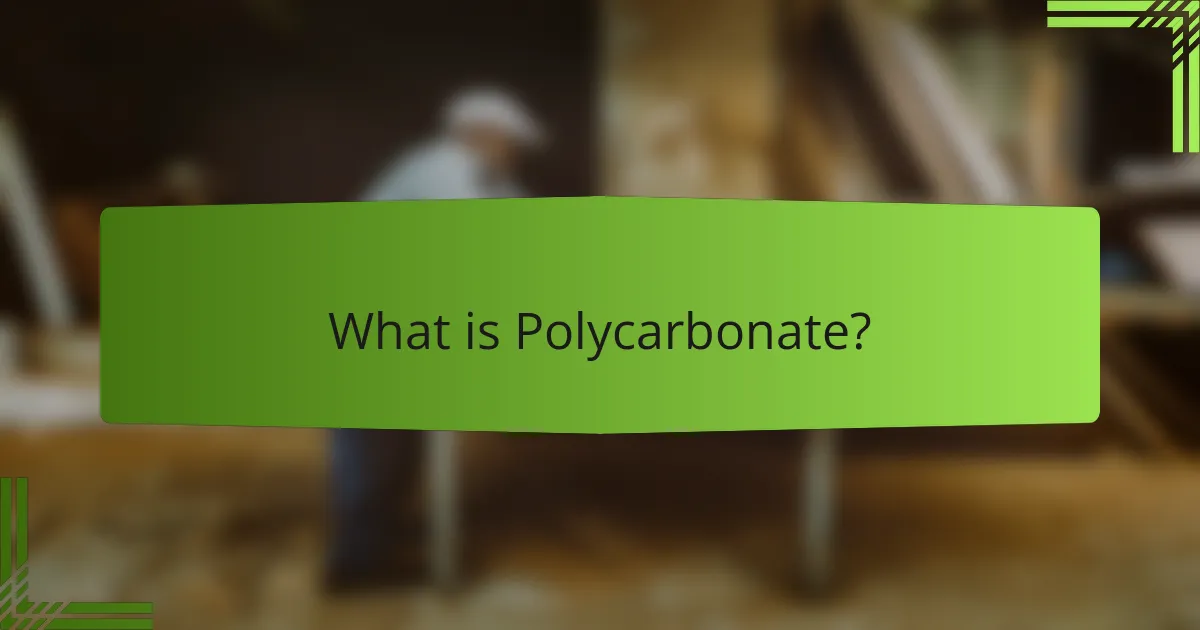
What is Polycarbonate?
Polycarbonate is a durable thermoplastic polymer known for its strength and transparency. It is widely used in various applications, including eyewear lenses, safety glasses, and electronic components. Polycarbonate has high impact resistance, making it suitable for protective gear. Additionally, it can withstand extreme temperatures, ranging from -40°C to 120°C. This polymer is lightweight, which enhances its usability in various products. Polycarbonate is also UV resistant, providing protection against harmful rays. Its versatility allows for easy molding and shaping in manufacturing processes. Overall, polycarbonate is a valuable material in industries requiring robust and transparent solutions.
How is Polycarbonate produced?
Polycarbonate is produced through a process called polymerization. This process typically involves the reaction of bisphenol A (BPA) with phosgene. The reaction occurs in a solvent, usually dichloromethane. This results in the formation of polycarbonate resin. The resin is then precipitated and washed to remove impurities. After washing, the resin is dried and can be further processed. The resulting polycarbonate can be shaped into various forms, such as sheets or molded products. The production process allows for the creation of a strong, transparent material used in numerous applications.
What raw materials are used in Polycarbonate production?
Polycarbonate production primarily uses bisphenol A (BPA) and phosgene as raw materials. BPA is an organic compound that serves as the primary building block for polycarbonate. Phosgene is a toxic gas that reacts with BPA to form polycarbonate through a polymerization process. The combination of these materials results in a durable, transparent plastic known for its impact resistance. The use of BPA and phosgene in polycarbonate production is well-documented in chemical manufacturing processes.
What are the key processes involved in making Polycarbonate?
The key processes involved in making polycarbonate include polymerization, extrusion, and molding. Polymerization is the initial step where bisphenol A and phosgene react to form polycarbonate resin. This reaction occurs in a controlled environment to ensure proper bonding. Following polymerization, the resin undergoes extrusion. During extrusion, the resin is heated and forced through a die to create sheets or other shapes. The extruded polycarbonate is then cooled and cut into desired dimensions. The final process is molding, where the polycarbonate is heated and shaped into specific products using molds. These processes collectively ensure the production of high-quality polycarbonate with desired properties.
What are the key properties of Polycarbonate?
Polycarbonate is a high-performance thermoplastic known for its key properties. It exhibits exceptional impact resistance, making it 200 times stronger than glass. Polycarbonate is also lightweight, with a density of approximately 1.2 g/cm³. This material has high transparency, allowing up to 90% light transmission. It possesses good thermal stability, maintaining its properties across a wide temperature range. Additionally, polycarbonate has excellent dimensional stability, resisting deformation under stress. It is also resistant to UV radiation, which helps prevent yellowing over time. These properties make polycarbonate suitable for various applications, including eyewear lenses, safety equipment, and architectural panels.
How does Polycarbonate compare to other plastics in terms of strength?
Polycarbonate is significantly stronger than many other plastics. It has a tensile strength of approximately 9,800 psi. This makes it more durable than materials like acrylic, which has a tensile strength of around 6,000 psi. Polycarbonate also exhibits high impact resistance, being nearly 200 times stronger than glass. In comparison, polyethylene has a tensile strength of about 3,000 psi. These properties make polycarbonate ideal for applications requiring high strength and durability, such as safety glasses and protective equipment.
What thermal properties does Polycarbonate exhibit?
Polycarbonate exhibits high thermal resistance and good thermal insulation properties. It can withstand temperatures ranging from -40°C to 120°C without significant deformation. Polycarbonate has a low thermal conductivity of approximately 0.2 W/m·K. This property makes it effective in minimizing heat transfer. Additionally, polycarbonate maintains its mechanical strength at elevated temperatures. It also has a high glass transition temperature, around 147°C. This allows polycarbonate to retain its shape under thermal stress. Overall, these thermal properties make polycarbonate suitable for various applications, including construction and automotive industries.
How does UV resistance affect the performance of Polycarbonate?
UV resistance significantly enhances the performance of polycarbonate. This characteristic allows polycarbonate to maintain its clarity and strength over time. UV exposure can cause yellowing and brittleness in materials lacking this resistance. Polycarbonate with UV resistance can withstand prolonged sunlight without degrading. Studies show that UV-resistant polycarbonate retains its physical properties for years. This makes it suitable for outdoor applications like roofing and glazing. The durability provided by UV resistance reduces the need for frequent replacements. Overall, UV resistance is crucial for the longevity and effectiveness of polycarbonate products.
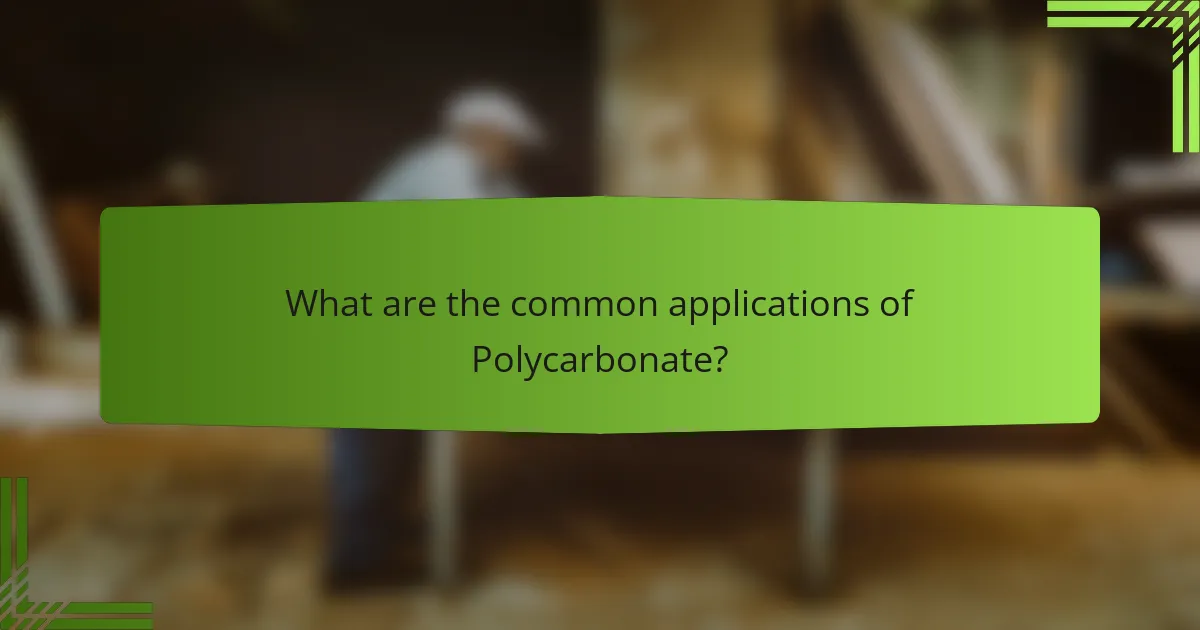
What are the common applications of Polycarbonate?
Polycarbonate is widely used in various applications due to its durability and transparency. Common applications include eyewear lenses, where polycarbonate provides impact resistance and UV protection. It is also used in safety goggles and face shields in industrial settings. Additionally, polycarbonate is utilized in the production of electronic components, such as housings and connectors, due to its excellent insulating properties. In construction, polycarbonate sheets are popular for roofing and glazing, offering lightweight and strong alternatives to glass. Furthermore, polycarbonate is employed in the automotive industry for parts like headlamp lenses and interior components. Its versatility makes it a preferred material across multiple sectors.
In which industries is Polycarbonate widely used?
Polycarbonate is widely used in various industries including automotive, construction, electronics, and consumer goods. In the automotive industry, it is utilized for making lightweight components and safety glasses. The construction sector employs polycarbonate for roofing, glazing, and safety barriers due to its durability and impact resistance. Electronics manufacturers use polycarbonate in the production of housings and lenses for devices. Furthermore, consumer goods such as eyewear and household items often feature polycarbonate for its strength and clarity. These applications highlight polycarbonate’s versatility and essential role across multiple sectors.
What role does Polycarbonate play in the automotive industry?
Polycarbonate serves as a lightweight and durable material in the automotive industry. It is commonly used for manufacturing components such as headlamp lenses and interior parts. Its impact resistance makes it ideal for safety applications. Polycarbonate also offers excellent optical clarity, enhancing visibility in automotive lighting. Additionally, it can be molded into complex shapes, allowing for innovative designs. The material’s ability to withstand extreme temperatures contributes to its reliability in various climates. Furthermore, polycarbonate is often chosen for its energy efficiency during production. These attributes collectively support its widespread adoption in modern vehicles.
How is Polycarbonate utilized in construction and architecture?
Polycarbonate is utilized in construction and architecture primarily for its lightweight and durable properties. It is commonly used in roofing systems, allowing natural light to penetrate while providing insulation. Polycarbonate panels are also employed in facades for energy efficiency and aesthetic appeal. Additionally, this material is used in skylights, greenhouses, and safety glazing due to its impact resistance. Its versatility allows for various applications, including partitions and safety barriers. Studies show that polycarbonate can reduce energy costs by enhancing natural lighting in buildings.
What are some innovative uses of Polycarbonate?
Polycarbonate is used innovatively in various applications. It is commonly utilized in eyewear lenses due to its lightweight and impact-resistant properties. In construction, polycarbonate panels serve as energy-efficient glazing materials. Automotive manufacturers use polycarbonate for lightweight components, improving fuel efficiency. Additionally, it is employed in the production of safety helmets, providing high durability and protection. The medical industry utilizes polycarbonate for sterilizable components in devices. Furthermore, polycarbonate is found in electronic devices, offering excellent insulation and protection for sensitive components. Its versatility makes it suitable for 3D printing, allowing for complex designs.
How is Polycarbonate being used in consumer electronics?
Polycarbonate is widely used in consumer electronics for its durability and lightweight properties. It is commonly found in smartphone cases, laptop shells, and protective screens. Polycarbonate provides impact resistance, making devices less prone to damage from drops. The material also offers excellent optical clarity, enhancing display quality in screens. Additionally, polycarbonate can be molded into complex shapes, allowing for innovative designs in electronics. Its heat resistance is beneficial for devices that generate heat during operation. Manufacturers prefer polycarbonate for its versatility and ability to withstand harsh conditions. These attributes contribute to the longevity and performance of consumer electronic products.
What are the applications of Polycarbonate in medical devices?
Polycarbonate is widely used in medical devices due to its strength and clarity. It is commonly found in components like surgical instruments, housings for medical equipment, and drug delivery systems. Polycarbonate’s impact resistance makes it ideal for devices that require durability. Its transparency allows for easy visualization of contents in syringes and IV bags. Additionally, polycarbonate can be sterilized, making it suitable for use in sterile environments. The material’s biocompatibility is crucial for applications involving direct contact with patients. These properties ensure that polycarbonate meets the stringent requirements of the medical industry.
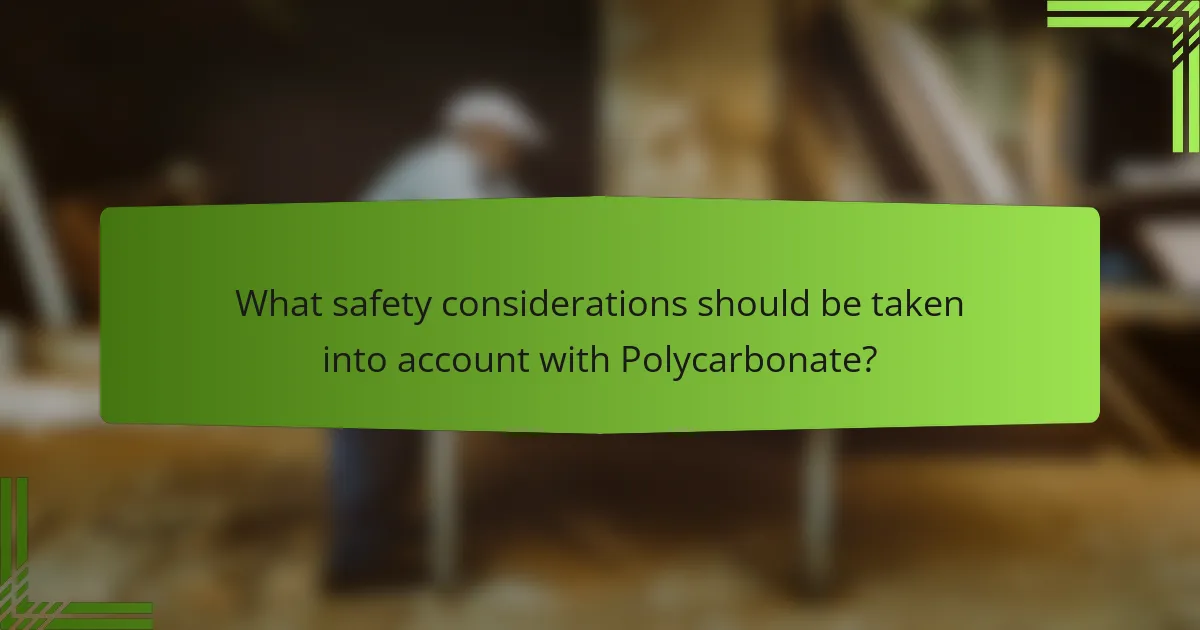
What safety considerations should be taken into account with Polycarbonate?
Polycarbonate is a durable thermoplastic known for its strength and impact resistance. However, safety considerations include its potential for UV degradation over time. Prolonged exposure to UV light can lead to yellowing and loss of structural integrity. Polycarbonate can also release harmful chemicals if exposed to high temperatures. This is particularly important in applications involving heat, such as in automotive or lighting fixtures. Additionally, proper handling is necessary to avoid injuries from sharp edges or fragments when broken. Safety data sheets (SDS) emphasize these hazards, outlining recommended practices for safe use.
Are there any health risks associated with Polycarbonate?
Polycarbonate can pose health risks primarily due to the chemical bisphenol A (BPA). BPA is an endocrine disruptor linked to various health issues. Studies indicate that BPA exposure may lead to reproductive harm and developmental problems. Research published in “Environmental Health Perspectives” highlights potential associations between BPA and increased risks of certain cancers. Additionally, high temperatures can cause polycarbonate to leach BPA into food and beverages. Therefore, care should be taken when using polycarbonate products, especially for food storage.
What are the concerns regarding BPA in Polycarbonate products?
Concerns regarding BPA in polycarbonate products include potential health risks. Bisphenol A (BPA) is an endocrine disruptor. Studies indicate BPA exposure may lead to hormonal imbalances. Research has linked BPA to reproductive issues and developmental problems. The U.S. Food and Drug Administration (FDA) has raised concerns about BPA in food containers. Some countries have banned BPA in baby bottles. The presence of BPA in polycarbonate can leach into food and beverages. This leaching poses risks, especially in high-temperature conditions.
How can exposure to Polycarbonate be minimized in manufacturing?
Exposure to polycarbonate in manufacturing can be minimized through several effective strategies. First, using engineering controls such as local exhaust ventilation can capture airborne particles. Second, employing personal protective equipment (PPE) like respirators and gloves reduces direct contact. Third, implementing safe handling procedures during material processing limits exposure risks. Fourth, conducting regular training for workers on safety protocols ensures awareness. Lastly, substituting polycarbonate with safer alternatives when possible can further reduce exposure. These measures are supported by workplace safety guidelines that emphasize minimizing harmful exposure to materials.
What are the environmental impacts of Polycarbonate?
Polycarbonate has several environmental impacts. Production of polycarbonate involves significant energy consumption and greenhouse gas emissions. The manufacturing process releases toxic substances, including bisphenol A (BPA), which can contaminate water sources. Polycarbonate is not biodegradable, contributing to long-term plastic pollution in landfills and oceans. Recycling rates for polycarbonate are low, exacerbating waste issues. When incinerated, polycarbonate can release harmful chemicals into the atmosphere. These factors collectively raise concerns about its sustainability and environmental footprint.
How is Polycarbonate recycled and what are the challenges involved?
Polycarbonate is recycled through mechanical and chemical processes. In mechanical recycling, the material is shredded into small flakes. These flakes are then washed to remove contaminants. After washing, the flakes are melted and reformed into new products. Chemical recycling involves breaking down polycarbonate into its monomers. This process allows for the creation of new polycarbonate from recycled materials.
Challenges in recycling polycarbonate include contamination during collection. Contaminants can affect the quality of recycled material. Additionally, the high melting point of polycarbonate complicates the recycling process. Limited infrastructure for recycling polycarbonate is another challenge. There is also a lack of awareness regarding the recyclability of polycarbonate products. These factors hinder the efficiency of recycling efforts.
What alternatives to Polycarbonate exist for eco-friendly applications?
Alternatives to polycarbonate for eco-friendly applications include bio-based plastics, glass, and recycled materials. Bio-based plastics, such as polylactic acid (PLA), are derived from renewable resources like cornstarch. Glass is fully recyclable and has a long lifespan, making it an environmentally friendly option. Recycled plastics can also serve as alternatives, reducing waste and energy consumption. Each of these materials offers lower environmental impact compared to polycarbonate.
What best practices should be followed when using Polycarbonate?
When using polycarbonate, it is essential to follow specific best practices to ensure safety and effectiveness. Always wear protective gear such as gloves and goggles to prevent injury during handling. Use sharp tools for cutting to achieve clean edges and avoid cracking. Store polycarbonate sheets flat in a cool, dry place to prevent warping. Clean surfaces with mild soap and water to maintain clarity without damaging the material. Avoid exposing polycarbonate to harsh chemicals or solvents that can degrade it. When installing, use appropriate fasteners and avoid over-tightening to prevent stress fractures. Lastly, ensure proper ventilation during any thermal processing to prevent fumes. These practices help maintain the integrity and performance of polycarbonate in various applications.
How can Polycarbonate be maintained for longevity?
To maintain polycarbonate for longevity, clean it regularly with mild soap and water. Use a soft cloth to avoid scratches. Avoid harsh chemicals and solvents, as they can damage the surface. Store polycarbonate sheets in a cool, dry place to prevent warping. Protect it from extreme temperatures and UV exposure by using protective coatings. Regular inspections for scratches or damage will help identify issues early. Following these practices can extend the life of polycarbonate significantly.
What are the recommended storage conditions for Polycarbonate products?
Polycarbonate products should be stored in a cool, dry place away from direct sunlight. Ideal storage temperatures range from 10°C to 30°C (50°F to 86°F). High temperatures can cause deformation or loss of structural integrity. Humidity should be kept low to prevent moisture absorption. Avoid storing polycarbonate near chemicals that can cause degradation. Ensure that the products are not subjected to heavy loads during storage. Proper ventilation is also important to maintain optimal conditions. These guidelines help preserve the quality and longevity of polycarbonate products.
Polycarbonate is a durable thermoplastic polymer recognized for its strength, transparency, and versatility across various applications such as eyewear lenses, safety equipment, and electronic components. The article evaluates its key properties, including high impact resistance, thermal stability, and UV resistance, as well as the production processes involving bisphenol A (BPA) and phosgene. It also addresses the common applications in industries like automotive and construction, while highlighting safety considerations related to BPA exposure and environmental impacts. Finally, the article discusses best practices for maintenance and storage to ensure the longevity of polycarbonate products.
